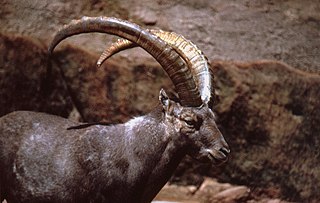
An ibex is any of several species of wild goat , distinguished by the male's large recurved horns, which are transversely ridged in front. Ibex are found in Eurasia, North Africa and East Africa.

Capra is a genus of mammals, the goats, comprising ten species, including the markhor and several species known as ibexes. The domestic goat is a domesticated species derived from the bezoar ibex. It is one of the oldest domesticated species of animal—according to archaeological evidence its earliest domestication occurred in Iran at 10,000 calibrated calendar years ago.
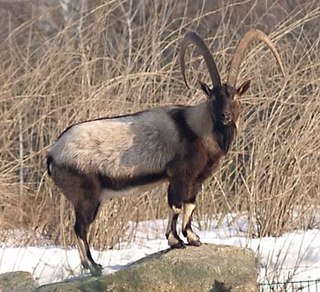
The wild goat is a wild goat species, inhabiting forests, shrublands and rocky areas ranging from Turkey and the Caucasus in the west to Turkmenistan, Afghanistan and Pakistan in the east. It has been listed as near threatened on the IUCN Red List and is threatened by destruction and degradation of habitat.

The argali, also known as the mountain sheep, is a wild sheep native to the highlands of western East Asia, the Himalayas, Tibet, and the Altai Mountains.

The Marco Polo sheep is a subspecies of argali sheep, named after Marco Polo. Their habitat are the mountainous regions of Central Asia. Marco Polo sheep are distinguishable mostly by their large size and spiraling horns. Their conservation status is "near threatened" and efforts have been made to protect their numbers and keep them from being hunted. It has also been suggested that crossing them with domestic sheep could have agricultural benefits.
The Naltar Wildlife Sanctuary is a protected area located in the Naltar Valley near Nomal, in Gilgit-Baltistan, Pakistan. The sanctuary was created on 22 November 1975 and consists of a steep-sided forested valley with high mountains on either side. The sanctuary is home to a number of large mammals, including a small number of Astor markhor.
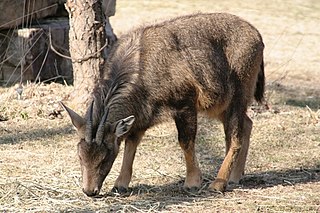
The long-tailed goral or Amur goral is a species of ungulate of the family Bovidae found in the mountains of eastern and northern Asia, including Russia, China, and Korea. A population of this species exists in the Korean Demilitarized Zone, near the tracks of the Donghae Bukbu Line. The species is classified as endangered in South Korea, with an estimated population less than 250. It has been designated South Korean natural monument 217. In 2003, the species was reported as being present in Arunachal Pradesh, in northeast India.
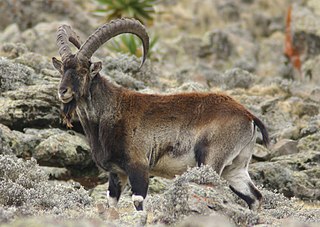
The Walia ibex is a vulnerable species of ibex. It is sometimes considered an endemic subspecies of the Alpine ibex. If the population were to increase, the surrounding mountain habitat would be sufficient to sustain only 2,000 ibex. The adult Walia ibex's only known wild predator is the hyena. However, young ibex are often hunted by a variety of fox and cat species. The ibex are members of the goat family, and the walia ibex is the southernmost of today's ibexes. In the late 1990s, the Walia ibex went from endangered to critically endangered due to the declining population. The Walia ibex is also known as the Abyssinian ibex. Given the small distribution range of the Walia ibex in its restricted mountain ecosystem, the presence of a large number of domestic goats may pose a serious threat that can directly affect the survival of the population.
Afghanistan has long been known for diverse wildlife. Many of the larger mammals in the country are categorized by the International Union for Conservation of Nature as globally threatened. These include the snow leopard, Marco Polo sheep, Siberian musk deer, markhor, urial, and the Asiatic black bear. Other species of interest are the ibex, the gray wolf, and the brown bear, striped hyenas, and numerous bird of prey species. Most of the Marco Polo sheep and ibex are being poached for food, whereas wolves, snow leopards and bears are being killed for damage prevention.
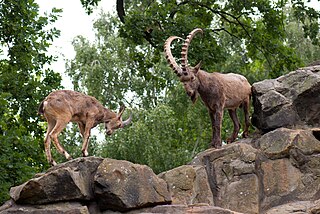
The Siberian ibex, also known using regionalized names including Altai ibex,Asian ibex, Central Asian ibex, Gobi ibex, Himalayan ibex, Mongolian ibex or Tian Shan ibex, is a polytypic species of ibex, a wild relative of goats and sheep. It lives in Central Asia, and is, by far, the most widely-distributed species in the genus Capra. In terms of population stability, Siberian ibex are currently ranked as Near Threatened, mostly due to over-hunting, low densities and overall decline; still, reliable data is minimal and difficult to come by, in addition to the animals’ expansive natural range, so accurate observations are still scant. The Siberian ibex has, formerly, been treated as a subspecies of the Eurasian Alpine ibex, and whether or not it is a single species or a complex of distinct units that stand out as genetically-distinct is still not entirely clear. The Siberian ibex is the longest and heaviest member of the genus Capra, though its shoulder height is slightly surpassed by the markhor.

Chitral Gol National Park is one of the National Parks of Pakistan. It is located in Lower Chitral District in Khyber-Pakhtunkhwa province of Pakistan beside the Chitral River, at a distance of two hours drive from Chitral town. The park is also known as Chitral National Park.
Dashkin is a village in Astore, Pakistan. It is 85 km from Gilgit, the capital of Gilgit-Baltistan. It has over 5,000 inhabitants, primarily farmers and herdsmen.
The Astor markhor or flare-horned markhor is a subspecies of the markhor, native to Kashmir and northern Pakistan. To the west it reaches the easternmost parts of Afghanistan. The range of the Astor markhor is very scattered. At one time considered an "endangered species", conservation efforts have had some success and the largest subpopulation in Pakistan may now exceed 1000 individuals. As a result, the International Union for Conservation of Nature has rated its status as "near-threatened".
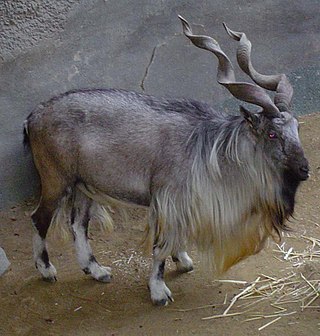
The Bukharan markhor, or Tadjik markhor is an endangered goat-antelope, native to Tajikistan, Turkmenistan and Uzbekistan, possibly also Afghanistan. Today it is found in few scattered populations, for example in Kugitang Nature Reserve in easternmost Turkmenistan. The population of the Bukharan markhor is at around 5,750 animals.
The Kabul markhor is a subspecies of Markhor. This near-threatened goat-antelope is native to Afghanistan and Pakistan.
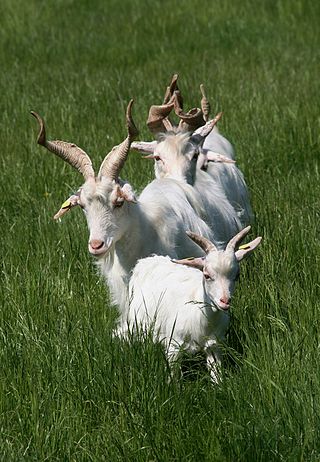
The Girgentana is an Italian breed of domestic goat indigenous to the province of Agrigento, in the southern part of the Mediterranean island of Sicily. The name of the breed derives from Girgenti, the name of Agrigento in local Sicilian language. There were in the past more than 30,000 head in the hills and coastal zone of the province. Today, however, this breed is in danger of disappearance.

The Hindu Kush alpine meadow ecoregion covers a portion of the Hindu Kush Mountain Range in northern Afghanistan. Most of the terrain is between 3,000 and 4,000 meters in elevation. This portion of the Hindu Kush is very mountainous, with steep slopes. About half of the alpine meadow is bare rock or gravely soils with sparse vegetation. The remainder supports herbaceous cover of grasses and cushion plants. Human habitation is scarce and follows the river courses in the valleys.
The Sulaiman markhor or straight-horned markhor is a goat endemic to Asia. It is a subspecies of Capra falconeri. Scientists differ regarding whether it is the same subspecies as the Kabul markhor.

The Kashmir markhor, Pir Panjal markhor, or flare-horned markhor is a possible subspecies of Capra falconeri endemic to the Western Himalayas of India and Pakistan. Many, including the IUCN, do not consider it a separate subspecies.
Trophy Hunting in Pakistan is a form of hunting for sport in which parts of the hunted wild animals are kept and displayed as trophies. Pakistan harbors a collection of the most uncommon types of wild sheep and goats on the planet. These include the Blue Sheep, Kashmir, Astor, and Suleman Markhors, as well as Punjab, Blandford, and Afghan Urials, alongside the Himalayan and Sindh Ibex.



















